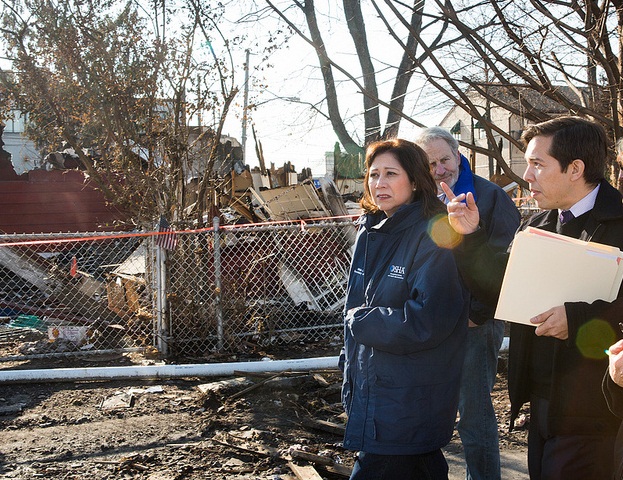
Secretary Solis visits Staten Island, N.Y., to view recovery and rebuilding efforts in the wake of Hurricane Sandy.
Last week, Secretary Solis toured areas of Staten Island, N.Y., and saw firsthand the devastation caused by Hurricane Sandy. It was her second trip to New York as part of the administration’s ongoing efforts to provide support for the hardest-hit areas. More than a month after the storm, piles of debris still remain where homes and businesses once stood. But there are other impacts that are harder to see.
Based on past experiences with other major hurricanes, we know that they can have a significant impact on employment through reduced hiring − as businesses downsize and close during and after the storms − and because it is difficult for job seekers to travel to interviews. And job losses can have a devastating effect on households who also have lost their homes, belongings, and in some cases, loved ones.
Preliminary evidence suggests that Sandy will be the second costliest storm in U.S. history. We already know that the economy experienced weaker retail sales and lower industrial production in October as a result of the storm. And in the first week following Sandy, Unemployment Insurance claims increased by 25 percent.
The official unemployment rate for November will be based on individuals’ activities in the first week after Sandy (Nov. 4-10), so that measure also could be affected. In other states, we have seen employment drop after hurricanes and sometimes take many months to recover. For example, a study examining the employment impacts of hurricanes in Florida found that hurricanes in that state generated employment drops of between 1.5 and 5 percent, depending on the strength of the hurricane.
Jobs in a variety of industries have been impacted by hurricanes and the largest losses can occur in service-related industries, which mostly depend on local demand. Given the importance of service sector jobs in the regions affected by Sandy, we may be seeing large drops in employment in the next few months in New Jersey and New York. (See the Bureau of Labor Statistics release on the pre-Sandy characteristics of the areas affected by the hurricane.)
It is reasonable to expect drops in employment and increases in unemployment after Sandy. However, as with other recent economic statistics (such as industrial production and retail sales), we’ll have to be careful with the interpretation of the survey data. A further complication is that the reference week was one week earlier than the usual reference week (the one containing the 12th of the month) because of where Thanksgiving fell on the calendar. For this reason, the household data refer to the week following the storm and the data collection started two weeks following the storm, a time when many people in mid-Atlantic states still faced disruptions in electricity and transportation.
One of the lessons learned from past hurricanes is that it is important to reach out to the residents and victims sooner rather than later. This is precisely why the administration is ensuring that support reaches those affected by Hurricane Sandy quickly. The Labor Department has already authorized the availability of $46.7 million in National Emergency Grants for New Jersey, New York, Rhode Island and Connecticut. The department has also made more than $2 million in Disaster Unemployment Assistance available to individuals whose jobs were interrupted or lost as a direct result of Sandy. Although the residents of the affected areas, local economies and the national economy will likely feel the effects of Sandy for some time, the assistance and support of the federal government and private sector will be crucial in generating infrastructure investments, which in turn will bring back both jobs and economic growth.


{ 4 comments… read them below or add one }
That’s really very good system
It’s crazy how much damage nature can do. With the unemployment rate skyrocketing, you’re right; it’s important to reach out now as opposed to later.
It seems that it is important business for businesses to make it their business to provide for the victims of Sandy. I believe we as a people can get together and get it done.
I am sorry to hear this. I hope all things going to be all right soon.